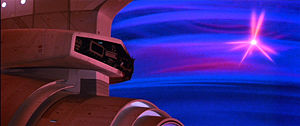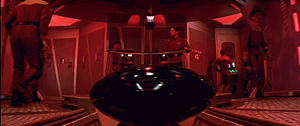Photon torpedo

Photon torpedoes are secondary missile weapons used by the starships of the United Federation of Planets. They do damage via the release of gamma rays from a matter-antimatter reaction.
Various alien powers use weapons that are visually similar to, or identified as, photon torpedoes. Whether they use the same operating principle is unknown; although photon torpedoes were in use by the Vulcans and Klingons well before the Federation existed (ENT), so Federation photon torpedoes are likely based on their designs.
Smaller Federation craft, such as the Delta Flyer, are sometimes armed with "photonic" missiles that are essentially miniature photon torpedoes.
Features
Variable Yields
Photon torpedoes have been observed to have vastly different yields. Many of them can be explained through deliberate "dialing down" of the yields to avoid friendly fire, such as in The Final Frontier. However, a popular theory is the antimatter injection theory. Since the release of the High Definition version of Star Trek II: The Wrath of Khan, torpedoes have been confirmed to have their antimatter payload inserted "just in time." As well, torpedo casings are noted in numerous episodes without their warhead.
Therefore, the difference between the tactical yield and maximum yield is a function of time, with more time required to ready the torpedo for a greater yield. In The Wrath of Khan special measures are taken to preload torpedoes in anticipation of battle.
Based on the energy required to destroy an asteroid, TNG-era photon torpedoes have a maximum yield of hundreds of kilotons.[1]
Trekkie Yield Claims
Trekkies have argued that the episode "Skin of Evil", in which a photon torpedo detonation on a planet is viewed from orbit, indicates a yield of as much as 9.83 gigatons (air blast) to 144 gigatons (fireball), but the effect seen appears and disappears far too quickly to be either phenomenon. Their "low end estimate", assuming the effect seen was result of thermal radiation, is 500 megatons.
Data from TNG and DS9 Technical Manuals
According to the non-canon TNG Technical Manual, a photon torpedo can carry up to 1.5 kg of antimatter, giving it a theoretical maximum yield of 64 megatons. Based on a 74% efficiency estimate found in the DS9 Technical Manual, the actual energy release would be closer to 48 megatons for a maximum-yield torpedo. These yield estimates are incompatible with evidence from canon events.
Propulsion
Photon torpedoes have a sublight propulsion system that allows them to accelerate and change course at sublight speeds; this is presumably a small impulse engine. They also have a guidance system that allows them to track a target using built-in sensors.
Photon torpedoes do not have a warp drive, but they do have something called a "sustainer engine" that allows them to keep travelling at warp speed if launched from a starship that is already traveling at warp.[2] Since this propulsion system is described as a "sustainer", it stands to reason that a photon torpedo cannot accelerate to a greater warp speed after launch.
Shielding
Torpedoes in the 24th century have shielding of unspecified strength. For example, a torpedo which was being used for a specific research purpose had a shield that allowed it to survive briefly inside a star.[3] Torpedoes can also burrow underground for at least a short time without being destroyed or detonated,[4] an activity that may be related to shielding. The specific purpose of torpedo shielding isn't clear, but Mike Wong has hypothesized that their primary purpose is to allow the torpedo to pass through the launching ship's shields via wave cancellation.[5] They could potentially also pass unimpeded through a target's shield if the frequency is known. The shield may also provide a small amount of resistance to point defense weapons.
Some Trekkies have suggested that the signature glow of torpedoes is a side effect of shielding; therefore, 23rd and 22nd century torpedoes which glow also have shielding. However, photon torpedoes still glowed in the Battle of the Mutara Nebula, where shields were supposedly disabled, indicating that the glow is not indicative of shielding. [6]
Loading Mechanism

As witnessed in The Wrath of Khan, torpedoes are stored and ferried to their launchers by a complex system of pulleys and conveyor belts on Constitution-class starships. Such a system would be highly prone to failure under battle stress, and it is common for enemies to target specific weapons systems and disable them. Due to the "leaky" nature of Star Trek's shields, a pinpoint strike against a ship even with its shields up could knock out the conveyor system.
Recent incarnations of Starfleet ships such as the Enterprise-E have more torpedo launchers. These additional torpedo launchers are nowhere near the size of the torpedo bays on Galaxy-class, Constitution-class, or other Starfleet vessels. Rather than assume greater firepower due to increased number of torpedo launchers, another more elegant explanation is the Federation attempting to do away with this conveyor system.
One example is the launcher on top of the observation lounge on the Enterprise-E. Presumably the launcher is single shot, because there is no room for the complex machinery required for the conveyor system or there is a small magazine of torpedos that can be loaded into the launcher. Another possibility is a site-to-site transport. All of these approaches present serious problems of their own.
The most satisfying solution might be to forego antimatter torpedoes altogether, but the Federation apparently deems the additional firepower worth the risk.
Field Construction
TNG "Samaritan Snare" indicates that it is possible to construct a photon torpedo from parts in the field, but this does not seem to be a preferred option. In ST6, the crew of the Enterprise manually counted the torpedoes in their magazine to prove that sensor logs of a launch from the ship had to be fake; this would not be compelling evidence if torpedoes were easy to replace in the field.
See Also
External Links
- Stardestroyer.net article on photon torpedoes
- Picard578's trekkie calculations.
Notes
- ↑ TNG "The Pegasus"
- ↑ TNG "Half a Life"
- ↑ TNG "Half a Life"
- ↑ TNG "Pen Pals"
- ↑ Frequency Myths on Stardestroyer.net
- ↑ Star Trek II: The Wrath of Khan